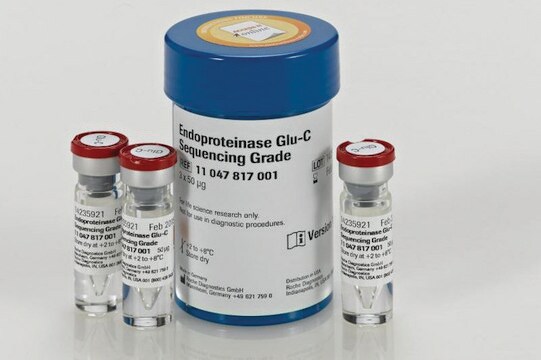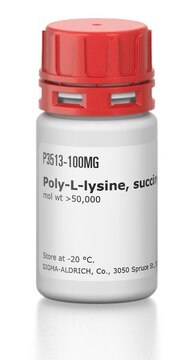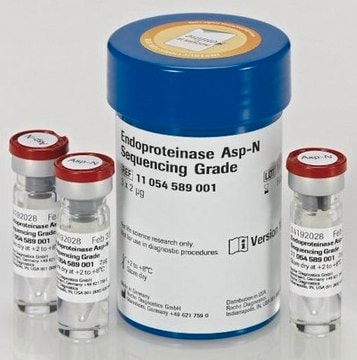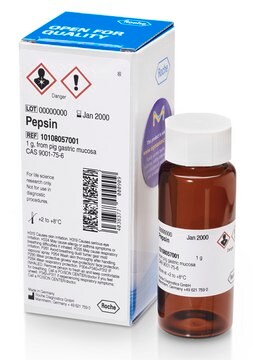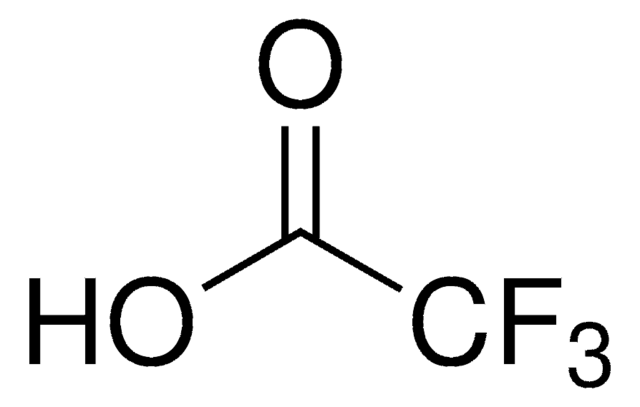P6181
Endoproteinase Glu-C from Staphylococcus aureus V8
suitable for protein sequencing, lyophilized powder
Synonym(s):
V8 Protease
Sign Into View Organizational & Contract Pricing
All Photos(1)
About This Item
CAS Number:
EC Number:
MDL number:
UNSPSC Code:
12352204
NACRES:
NA.54
Recommended Products
grade
Proteomics Grade
Quality Level
form
lyophilized powder
analyte chemical class(es)
amino acids
suitability
suitable for protein sequencing
storage temp.
−20°C
Looking for similar products? Visit Product Comparison Guide
Application
Endoproteinase Glu-C from Staphylococcus aureus V8 has been used for:
- obtaining proteolytic cleavage fragments of the S-layer protein (from Bacillus stearothermophilus ATCC 12980) to perform affinity studies.
- the enzymatic cleavage of native VSTx-3 (voltage sensor toxin 3) peptide for its sequence determination.
- limited proteolysis of recombinant purified PimA (phosphatidylinositol mannosyltransferase).
- the digestion of glycosylated hemoglobin for isotope dilution liquid chromatography-tandem mass spectrometry analysis.
Biochem/physiol Actions
Endoproteinase Glu-C from Staphylococcus aureus strain V8 is a serine endoprotease, which hydrolyzes peptide bonds at the carboxyl side of glutamyl and aspartyl residues. The specificity of Glu-C is dependent upon the buffer and pH employed as well as the structure around the potential cleavage site. In ammonium acetate (pH 4.0) or ammonium bicarbonate (pH 7.8), the enzyme preferentially cleaves glutamyl bonds; whereas, in phosphate buffer (pH 7.8) Glu-C will cleave at either site. Glu-C is reported to be active in the presence of 0.2% SDS (sodium dodecyl sulfate) and in 4.0M urea.
Signal Word
Danger
Hazard Statements
Precautionary Statements
Hazard Classifications
Resp. Sens. 1 - Skin Sens. 1
Storage Class Code
11 - Combustible Solids
WGK
WGK 3
Personal Protective Equipment
dust mask type N95 (US), Eyeshields, Gloves
Choose from one of the most recent versions:
Already Own This Product?
Find documentation for the products that you have recently purchased in the Document Library.
Customers Also Viewed
Two tarantula venom peptides as potent and differential Na(V) channels blockers.
Cherki RS et al.
Toxicon, 77, 58-58 (2014)
Mechanism of acylphosphatase inactivation by Woodward's reagent K.
Paoli, P., et al.
The Biochemical Journal, 855-861, 855-861 (1997)
Kenneth AW
Human Genome Methods (1997)
The Protein Protocols Handbook (1996)
M Jarosch et al.
Microbiology (Reading, England), 146 ( Pt 2), 273-281 (2000-03-09)
The cell surface of Bacillus stearothermophilus ATCC 12980 is completely covered with an oblique S-layer lattice. To investigate sequence identities and a common structure-function relationship in S-layer proteins of different B. stearothermophilus wild-type strains, the nucleotide sequence encoding the S-layer
Our team of scientists has experience in all areas of research including Life Science, Material Science, Chemical Synthesis, Chromatography, Analytical and many others.
Contact Technical Service